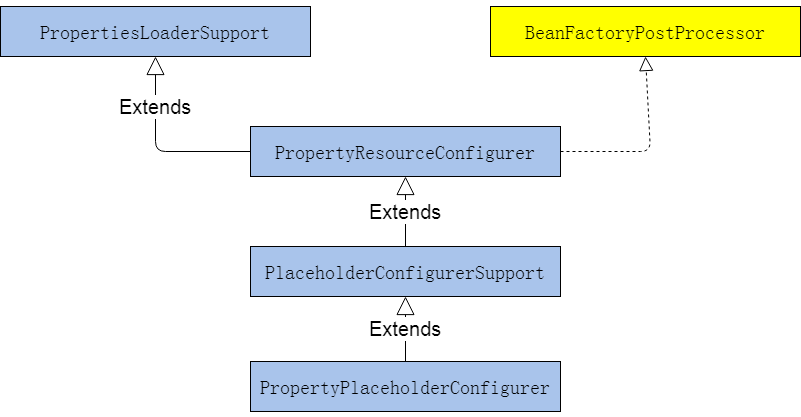Spring中@Value标签的使用详解
1.@Value标签
由于Spring对通过IOC的方式对对象进行统一管理,所以对任何对象而言,其生成方法均由Spring管理。传统的方法是通过XML配置每一个Bean,并对这个Bean的所有Field进行声明式配置。
以一个简单的学校的例子为示范。假设有两种角色,老师和班长。
package org.kingszelda.version3.controller; /**
* Created by shining.cui on 2017/7/30.
*/
public class Teacher { /**
* 姓名
*/
private String name = "王老师"; /**
* 教授科目
*/
private String major = "数学"; /**
* 教授课程班级的班长
*/
private ClassMonitor classMonitor = new ClassMonitor(); /**
* 老师会上课
*/
public void teachLesson() { } /**
* 老师要收作业,然而老师并不亲自收,而是交给班长收
*/
public void collectHomework() {
classMonitor.collectHomework();
} public String getName() {
return name;
} public void setName(String name) {
this.name = name;
} public String getMajor() {
return major;
} public void setMajor(String major) {
this.major = major;
} public ClassMonitor getClassMonitor() {
return classMonitor;
} public void setClassMonitor(ClassMonitor classMonitor) {
this.classMonitor = classMonitor;
}
}
老师有自己的名字和教授的科目两个属性,这属于老师的静态属性。老师有很多“功能“,比如上课和收作业。上课属于老师可以自己完成的功能,而收作业则需要班长帮忙。所以老师为了完成自己的工作是不能独立存在的,需要依赖班长。
/**
* Created by shining.cui on 2017/7/30.
*/
public class ClassMonitor { public void collectHomework(){
System.out.println("开始收作业了!");
System.out.println("收作业完毕");
}
}
这里我们假设班长只有一个功能,就是收作业。
上面的例子很好的说明了对象之间相互依赖共同合作的方法,即互相依赖。这些功能交给spring之后管理起来就方便多了,以xml的方式为例,需要如下配置:
<?xml version="1.0" encoding="UTF-8"?>
<beans xmlns="http://www.springframework.org/schema/beans"
xmlns:xsi="http://www.w3.org/2001/XMLSchema-instance"
xmlns:context="http://www.springframework.org/schema/context"
xsi:schemaLocation="http://www.springframework.org/schema/beans http://www.springframework.org/schema/beans/spring-beans.xsd http://www.springframework.org/schema/context http://www.springframework.org/schema/context/spring-context.xsd"> <bean id="classMonitor" class="org.kingszelda.version3.controller.ClassMonitor"/>
<bean id="teacher" class="org.kingszelda.version3.controller.Teacher">
<property name="name" value="王老师"/>
<property name="major" value="数学"/>
<property name="classMonitor" ref="classMonitor"/>
</bean>
</beans>
通过这种配置的方式之后,实体之间的依赖关系变得一清二楚。比如Teacher的名字,科目,所依赖的班长是哪个,只看配置文件就可以一目了然。但是,当实体变多了之后,可想而知,这个xml配置文件将庞大的不可想象,就更不要提可读性了。
于是Spring从3.0开始推出了基于注解的形式,来简化配置。
package org.kingszelda.version3.controller; import org.springframework.beans.factory.annotation.Value;
import org.springframework.stereotype.Service; import javax.annotation.Resource; /**
* Created by shining.cui on 2017/7/30.
*/
@Service
public class Teacher { /**
* 姓名
*/
@Value("王老师")
private String name; /**
* 教授科目
*/
@Value("数学")
private String major; /**
* 教授课程班级的班长
*/
@Resource
private ClassMonitor classMonitor; /**
* 老师会上课
*/
public void teachLesson() { } /**
* 老师要收作业,然而老师并不亲自收,而是交给班长收
*/
public void collectHomework() {
classMonitor.collectHomework();
}
}
通过注解的形式已经减少了大量的get、set方法,通过@Resource注入了依赖的班长,并且通过@Value注入了老师的姓名和科目。
问题来了,当姓名与科目如何做到可配置,而不是写死的呢?对应xml与注解都有其对应的方式。
首先声明一个config.perproties文件:
name=张老师
major=数学
xml:
<?xml version="1.0" encoding="UTF-8"?>
<beans xmlns="http://www.springframework.org/schema/beans"
xmlns:xsi="http://www.w3.org/2001/XMLSchema-instance"
xmlns:context="http://www.springframework.org/schema/context"
xsi:schemaLocation="http://www.springframework.org/schema/beans http://www.springframework.org/schema/beans/spring-beans.xsd http://www.springframework.org/schema/context http://www.springframework.org/schema/context/spring-context.xsd"> <context:property-placeholder location="classpath:config.properties"/>
<bean id="classMonitor" class="org.kingszelda.version3.controller.ClassMonitor"/>
<bean id="teacher" class="org.kingszelda.version3.controller.Teacher">
<property name="name" value="${name}"/>
<property name="major" value="${major}"/>
<property name="classMonitor" ref="classMonitor"/>
</bean>
</beans>
注解:
package org.kingszelda.version3.controller; import org.springframework.beans.factory.annotation.Value;
import org.springframework.stereotype.Service; import javax.annotation.Resource; /**
* Created by shining.cui on 2017/7/30.
*/
@Service
public class Teacher { /**
* 姓名
*/
@Value("${name}")
private String name; /**
* 教授科目
*/
@Value("${major}")
private String major; /**
* 教授课程班级的班长
*/
@Resource
private ClassMonitor classMonitor; /**
* 老师会上课
*/
public void teachLesson() { } /**
* 老师要收作业,然而老师并不亲自收,而是交给班长收
*/
public void collectHomework() {
classMonitor.collectHomework();
} }
我们看到,不论是通过xml配置,还是通过注解@Value的方式,姓名与科目都在生成Teacher对象是被赋值进去了。
2.@Value是如何起作用的

Spirng在生命周期里关于Bean的处理大概可以分为下面几步:
- 加载Bean定义(从xml或者从@Import等)
- 处理BeanFactoryPostProcessor
- 实例化Bean
- 处理Bean的property注入
- 处理BeanPostProcessor
而当我们在声明了<context:property-placeholder location="classpath:config.properties"/>标签之后,即声明了一个配置型bean交给Spring容器进行管理,即PropertyPlaceholderConfigurer类。我们先看一下这个类的继承结构。

蓝色的是功能性结构,实现了解析文件,处理文件的功能,黄色的是Spring的钩子功能,声明了功能性模块被调用的时机。这里PrepertyPlaceholderConfigurer实现了BeanFactoryPostProcesser接口,并实现了postProcessBeanFactory()方法即当Spring容器的BeanFactory被构造成功之后会调用这个方法。这里要注意,ApplicationContext也是BeanFactory的派生类。这时,我们先看父类的PropertyResourceConfigurer方法postProcessBeanFactory。因为这个类继承了Spring的BeanFactoryPostProcesser接口,所以这个方法一定是操作BeanFactory的。
@Override
public void postProcessBeanFactory(ConfigurableListableBeanFactory beanFactory) throws BeansException {
try {
//1.获取当前容器配置的所有Properties文件,可能由多个文件merge而来
Properties mergedProps = mergeProperties(); //2.如果需要的话,将Properties文件的内容进行转化,因为默认的Preperties都是String的key-value形式。
//Spring提供的默认方式是不转化,保持String,String的key-value
convertProperties(mergedProps); //3.由子类继承,对容器与Properties进行操作,即value注入。
processProperties(beanFactory, mergedProps);
}
catch (IOException ex) {
throw new BeanInitializationException("Could not load properties", ex);
}
}
这里最重要的第一步就是获得Properties文件即mergeProperties方法,这是解析资源文件最基本的方法,所以这个方法一定存在于当前功能的最基类中,即PropertiesLoaderSupport。由于xml中是这样配置的:
<context:property-placeholder location="classpath:config.properties"/>
这里声明了一个PropertyPlaceholderConfigurer对象,显然是调用了setLocation方法,而这个方法同样存在于该功能模块的最基本父类PropertiesLoaderSupport中。
public abstract class PropertiesLoaderSupport {
//……省略
private Resource[] locations;
//……省略
public void setLocation(Resource location) {
this.locations = new Resource[] {location};
}
//注意:晚声明的文件内容将覆盖早声明的文件内容,所以请自己保证文件之间内容不要重叠,否则以最后一个文件为准
public void setLocations(Resource... locations) {
this.locations = locations;
}
//……省略
}
mergeProperties方法中进行了配置化管理,针对某些标志位进行额外的操作,这里不做过多说明,其最重要的功能是调用了下面方法:
protected void loadProperties(Properties props) throws IOException {
if (this.locations != null) {
//1.遍历声明的Resource文件地址
for (Resource location : this.locations) {
if (logger.isInfoEnabled()) {
logger.info("Loading properties file from " + location);
}
try {
//2.获得Resource文件流,并加载内容到Properties对象中
PropertiesLoaderUtils.fillProperties(
props, new EncodedResource(location, this.fileEncoding), this.propertiesPersister);
}
catch (IOException ex) {
if (this.ignoreResourceNotFound) {
if (logger.isWarnEnabled()) {
logger.warn("Could not load properties from " + location + ": " + ex.getMessage());
}
}
else {
throw ex;
}
}
}
}
}
回想PropertyResourceConfigurer主流程中的三个方法,第一步已经执行完毕,加载了配置的properties文件,第二步是spring自己的默认实现,将非空的key对应的value放入Properties中,第三步则该由子类各自实现了,将BeanFactory与Properties进行统一操作。这时候我们看我们直接声明的派生类PropertyPlaceholderConfigurer。
@Override
protected void processProperties(ConfigurableListableBeanFactory beanFactoryToProcess, Properties props)
throws BeansException {
//1.声明一个支持value为String类型的Resolver
StringValueResolver valueResolver = new PlaceholderResolvingStringValueResolver(props);
//2.将key-value注入到BeanFactory的某些bean中
doProcessProperties(beanFactoryToProcess, valueResolver);
}
接下来就是真正的value注入环节了
protected void doProcessProperties(ConfigurableListableBeanFactory beanFactoryToProcess,
StringValueResolver valueResolver) {
//1.将key-value内容声明为BeanDefinitionVisitor对象,用来根据BeanDefinition修改即将生成的对应的Bean内容
BeanDefinitionVisitor visitor = new BeanDefinitionVisitor(valueResolver); String[] beanNames = beanFactoryToProcess.getBeanDefinitionNames();
for (String curName : beanNames) {
//2.只有同一个容器内的才可以进行value注入,同时应该避免掉操作本身,避免进入循环递归
if (!(curName.equals(this.beanName) && beanFactoryToProcess.equals(this.beanFactory))) {
BeanDefinition bd = beanFactoryToProcess.getBeanDefinition(curName);
try {
visitor.visitBeanDefinition(bd);
}
catch (Exception ex) {
throw new BeanDefinitionStoreException(bd.getResourceDescription(), curName, ex.getMessage(), ex);
}
}
} //3.处理一些拥有别名的类
beanFactoryToProcess.resolveAliases(valueResolver); //4.New in Spring 3.0: resolve placeholders in embedded values such as annotation attributes.(这一步有些不懂,以后再修正)
beanFactoryToProcess.addEmbeddedValueResolver(valueResolver); }
在上述代码中,第2步已经修改了原始的BeanDefinition,我们一路跟进去看,原来核心的替换功能在PropertyPlaceholderHelper中:
protected String parseStringValue(
String strVal, PlaceholderResolver placeholderResolver, Set<String> visitedPlaceholders) {
//1.对每一个key进行处理
StringBuilder result = new StringBuilder(strVal);
//2.首先考虑有占位符的情况,默认是${}
int startIndex = strVal.indexOf(this.placeholderPrefix);
while (startIndex != -1) {
int endIndex = findPlaceholderEndIndex(result, startIndex);
if (endIndex != -1) {
String placeholder = result.substring(startIndex + this.placeholderPrefix.length(), endIndex);
String originalPlaceholder = placeholder;
if (!visitedPlaceholders.add(originalPlaceholder)) {
throw new IllegalArgumentException(
"Circular placeholder reference '" + originalPlaceholder + "' in property definitions");
}
//3.如果有占位符,则去掉占位符递归调用本方法,即key=${abc},处理成key=abc的形式试图获取value
placeholder = parseStringValue(placeholder, placeholderResolver, visitedPlaceholders);
//4.真正的从key-value集合中获得key对应的value
String propVal = placeholderResolver.resolvePlaceholder(placeholder);
//5.如果没有找到,则试图按照${key:default}的形式解析
if (propVal == null && this.valueSeparator != null) {
int separatorIndex = placeholder.indexOf(this.valueSeparator);
if (separatorIndex != -1) {
//6.获得:之前的内容,即真正的key
String actualPlaceholder = placeholder.substring(0, separatorIndex);
//7.获得:之后的内容,即默认值
String defaultValue = placeholder.substring(separatorIndex + this.valueSeparator.length());
//8.再次尝试从key-value集合中获得内容,因为如果真的是key-value的形式,按照全名是肯定找不到的
propVal = placeholderResolver.resolvePlaceholder(actualPlaceholder);
//9.如果找到了就按照配置的走,如果没有找到则附上默认值
if (propVal == null) {
propVal = defaultValue;
}
}
}
if (propVal != null) {
//10.如果找到了这个value,则再次递归调用自己,避免value也是占位符的情况
propVal = parseStringValue(propVal, placeholderResolver, visitedPlaceholders);
//11.将获得的结果替换掉
result.replace(startIndex, endIndex + this.placeholderSuffix.length(), propVal);
if (logger.isTraceEnabled()) {
logger.trace("Resolved placeholder '" + placeholder + "'");
}
startIndex = result.indexOf(this.placeholderPrefix, startIndex + propVal.length());
}
else if (this.ignoreUnresolvablePlaceholders) {
// Proceed with unprocessed value.
startIndex = result.indexOf(this.placeholderPrefix, endIndex + this.placeholderSuffix.length());
}
else {
throw new IllegalArgumentException("Could not resolve placeholder '" +
placeholder + "'" + " in string value \"" + strVal + "\"");
}
visitedPlaceholders.remove(originalPlaceholder);
}
else {
startIndex = -1;
}
} return result.toString();
}
3.总结
Spring管理bean的方式大大减少了编程人员的编码复杂度,这个复杂度并没有消失,而是转嫁到Spring容器中。我们可以通过xml或者@value注解的方式注入field属性,这对多环境profiles的应用是非常关键的,掌握了Spring的这条注入路径之后,对于帮助理解Spring或者查找一些值注入的问题都非常有帮助。
Spring中@Value标签的使用详解的更多相关文章
- Spring中@Component注解,@Controller注解详解
在使用Spring的过程中,为了避免大量使用Bean注入的Xml配置文件,我们会采用Spring提供的自动扫描注入的方式,只需要添加几行自动注入的的配置,便可以完成 Service层,Controll ...
- Spring中的循环依赖解决详解
前言 说起Spring中循环依赖的解决办法,相信很多园友们都或多或少的知道一些,但当真的要详细说明的时候,可能又没法一下将它讲清楚.本文就试着尽自己所能,对此做出一个较详细的解读.另,需注意一点,下文 ...
- spring中Bean的注入参数详解
字面值 一般指可用字符串表示的值,这些值可以通过<value>元素标签进行注入.在默认情况下,基本数据类型及其封装类.String等类型都可以采取字面值注入的方式,Spring容器在 ...
- Spring中bean的作用域scope详解
参考文献:http://blog.csdn.net/jacklearntech/article/details/40157861 http://www.cnblogs.com/qq78292959/p ...
- Spring中Controller和RequestMapping的详解
先看一个简单的实例: @Controller @RequestMapping("/hello") public class anyTypeController{ @RequestM ...
- Spring中的ApplicationListener的使用详解案例
本文链接:https://blog.csdn.net/u010963948/article/details/83507185 1.ApplicationContext Spring的核心,Contex ...
- Spring中配置文件applicationContext.xml配置详解
<?xml version="1.0" encoding="UTF-8"?><beans xmlns="http://www.spr ...
- Python中with标签的使用详解
1.在python DTL模板中,想要定义变量,可以通过"with"语句来实现. 2."with"语句有两种使用方式: 第一种是"with xx=xx ...
- HTML video 视频标签全属性详解
HTML 5 video 视频标签全属性详解 现在如果要在页面中使用video标签,需要考虑三种情况,支持Ogg Theora或者VP8(如果这玩意儿没出事的话)的(Opera.Mozilla.C ...
随机推荐
- [BZOJ 4832][lydsy 4月赛] 抵制克苏恩
题面贴一发 [Lydsy2017年4月月赛]抵制克苏恩 Time Limit: 1 Sec Memory Limit: 128 MBSubmit: 443 Solved: 164[Submit][ ...
- Swift 细节
1.swift ?和 !的区别 1.1 Swift语言使用var定义变量,但和别的语言不同,Swift里不会自动给变量赋初始值,也就是说变量不会有默认值,所以要求使用变量之前必须要对其初始化.如果在使 ...
- 简易 HTTP Server 实现(JAVA)
该简易的J2EE WEB容器缺失很多功能,却可以提供给大家学习HTTP容器大致流程. 注:容器功能很少,只供学习. 1. 支持静态内容与Servlet,不支持JSP 2. 仅支持304/404 3. ...
- Python数据可视化Matplotlib——Figure画布背景设置
之前在今日头条中更新了几期的Matplotlib教学短视频,在圈内受到了广泛好评,现应大家要求,将视频中的代码贴出来,方便大家学习. 为了使实例图像显得不单调,我们先将绘图代码贴上来,此处代码对Fig ...
- React Native 系列(五) -- 组件间传值
前言 本系列是基于React Native版本号0.44.3写的.任何一款 App 都有界面之间数据传递的这个步骤的,那么在RN中,组件间是怎么传值的呢?这篇文章将介绍到顺传.逆传已经通过通知传值. ...
- 基于ubuntu14视觉识别乒乓球_1
串口通信,opencv3.0 窗口大小可调 编译 cmake ../ make ./color 正常光线下运行比较稳定,找圆比较准确.程序设置了圆的半径区间以及圆心最小间距,以满足产品的需求,可自行修 ...
- js单页hash路由原理与应用实战
什么是路由? 通俗点说,就是不同的URL显示不同的内容 什么是单页应用? 单页,英文缩写为SPA( Single Page Application),就是把各种功能坐在一个页面内. 那所谓的单页路由应 ...
- 用ubuntu的grpb2引导Remix OS
Remix OS游戏版,这里下载:http://youxi.jide.com/ 安装简单.我这里要解决的是安装后用ubunu的grub2菜单去引导它. 方法如下: 进入ubuntu系统里修改其grub ...
- echarts之词云随机颜色的配置
echarts中的词云字体产生随机颜色,最主演的是要引入worldcloud.js,另外还要有jquery.js文件与echarts.js文件的引入,通过配置即可实现词云随机颜色的产生.下面为大家介绍 ...
- U3D学习入门
U3D最重要的五大界面 第一:场景(Sence),构建游戏的地方: 第二:层级(Hierarchy),场景中的游戏对象都列在这里. 第三:检测面板(Inspector),当前选中的资源或对象的设置,是 ...
